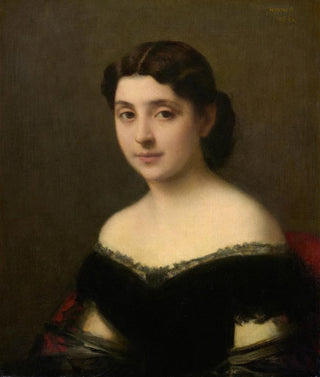Art print | Portrait of a woman - Jean-Jacques Henner


View from behind

Frame (optional)
Portrait of a Woman - Jean-Jacques Henner – Captivating Introduction
In the fascinating world of art, some works stand out for their ability to capture the very essence of humanity. The "Portrait of a Woman" by Jean-Jacques Henner is a shining example. This canvas, imbued with delicacy and mystery, invites us to delve into the intimacy of a female figure whose gaze seems to tell an endless story. The artist, through his refined technique and keen sense of light, manages to transcend the simple portrait to offer us a true emotional experience. The art print of this iconic piece allows us to appreciate the timeless beauty of this creation, while immersing us in the aesthetic universe of the late 19th century.
Style and uniqueness of the work
Henner, master of portraiture, is characterized by a unique style that combines sensuality and introspection. In the "Portrait of a Woman," the softness of features and the finesse of details are accentuated by a palette of warm colors, where shades of pink and gold intertwine to create an atmosphere that is both soothing and captivating. The subtle play of light, which caresses the woman's face, highlights her pensive, almost melancholic expression. This pictorial approach, where each brushstroke seems charged with emotion, gives the work a rare depth. By moving away from the academic conventions of his time, Henner manages to bring his subjects to life, making them both accessible and mysterious. The choice of pose, slightly turned, and the blurred background help to emphasize the intimacy of the moment, as if the viewer is invited to share a secret.
The artist and his influence
Jean-Jacques Henner, often associated with the Pre-Raphaelite movement, established himself as a major figure in 19th-century French art. Trained at the École des Beaux-Arts in Paris, he quickly developed a style that was uniquely his own, blending classical influences with personal innovations. His portraits, especially those of women, reveal a particular sensitivity towards female beauty, while incorporating symbolist elements that question the human condition. The artist was also a pioneer in the use of

Matte finish

View from behind

Frame (optional)
Portrait of a Woman - Jean-Jacques Henner – Captivating Introduction
In the fascinating world of art, some works stand out for their ability to capture the very essence of humanity. The "Portrait of a Woman" by Jean-Jacques Henner is a shining example. This canvas, imbued with delicacy and mystery, invites us to delve into the intimacy of a female figure whose gaze seems to tell an endless story. The artist, through his refined technique and keen sense of light, manages to transcend the simple portrait to offer us a true emotional experience. The art print of this iconic piece allows us to appreciate the timeless beauty of this creation, while immersing us in the aesthetic universe of the late 19th century.
Style and uniqueness of the work
Henner, master of portraiture, is characterized by a unique style that combines sensuality and introspection. In the "Portrait of a Woman," the softness of features and the finesse of details are accentuated by a palette of warm colors, where shades of pink and gold intertwine to create an atmosphere that is both soothing and captivating. The subtle play of light, which caresses the woman's face, highlights her pensive, almost melancholic expression. This pictorial approach, where each brushstroke seems charged with emotion, gives the work a rare depth. By moving away from the academic conventions of his time, Henner manages to bring his subjects to life, making them both accessible and mysterious. The choice of pose, slightly turned, and the blurred background help to emphasize the intimacy of the moment, as if the viewer is invited to share a secret.
The artist and his influence
Jean-Jacques Henner, often associated with the Pre-Raphaelite movement, established himself as a major figure in 19th-century French art. Trained at the École des Beaux-Arts in Paris, he quickly developed a style that was uniquely his own, blending classical influences with personal innovations. His portraits, especially those of women, reveal a particular sensitivity towards female beauty, while incorporating symbolist elements that question the human condition. The artist was also a pioneer in the use of






